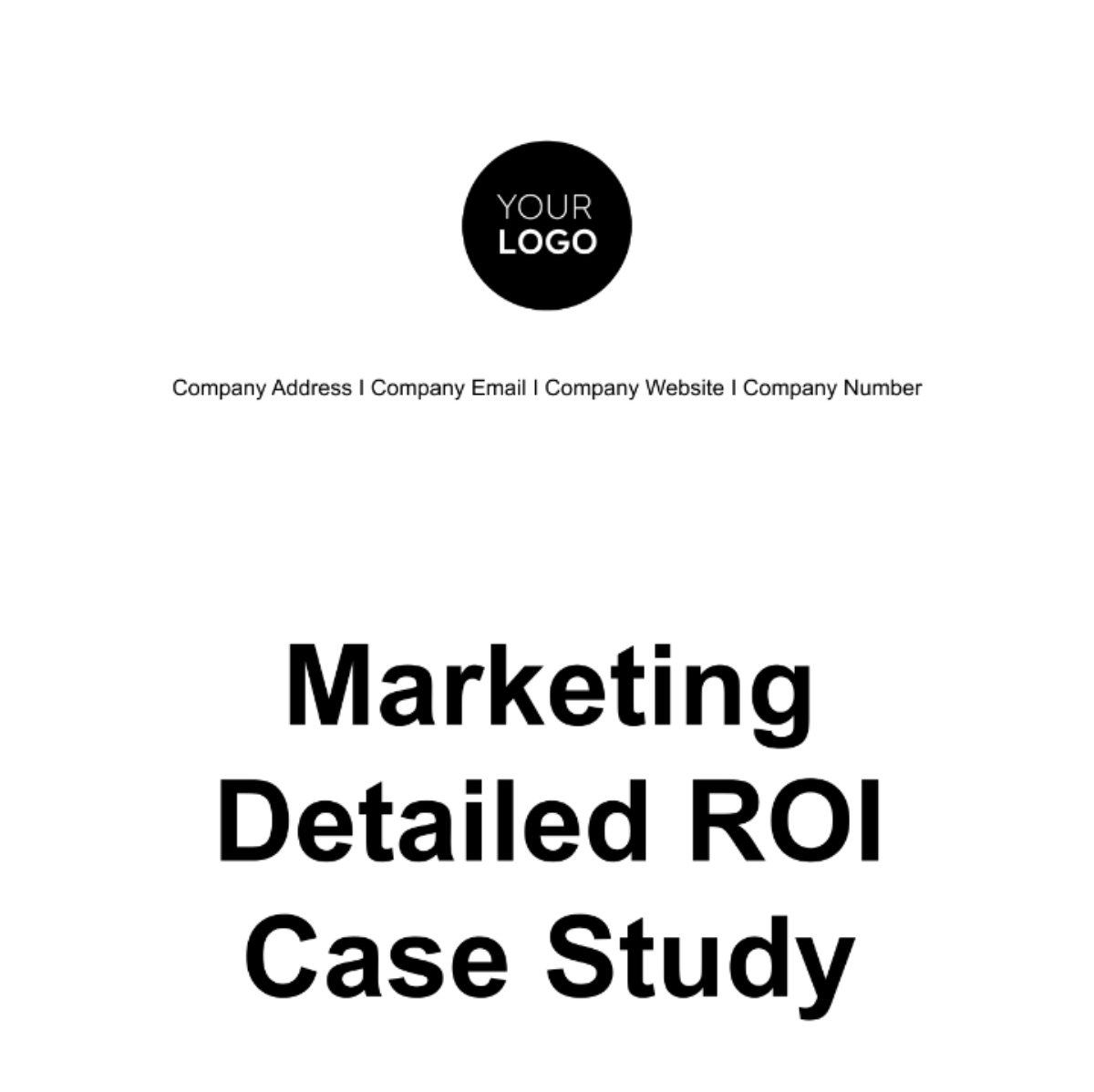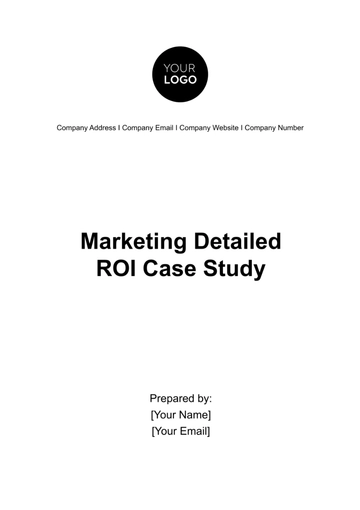Free Marketing Detailed ROI Case Study

1. Introduction
This Marketing Detailed ROI Case Study offers an in-depth analysis of a recent marketing initiative conducted by [Your Company Name] during the period spanning from January 1, 2050, to June 30, 2050. The primary objective of this campaign was to fortify our online presence, elevate brand recognition, and foster revenue growth by harnessing cutting-edge digital marketing strategies.
In an era defined by ever-evolving digital landscapes, our organization recognized the imperative to adapt and innovate our marketing strategies. With this insight, we launched an ambitious marketing campaign designed to align with our overarching objectives and maintain a competitive edge within our industry.
The ensuing pages will provide a comprehensive exploration of the campaign's journey, encompassing its objectives, methodology, performance metrics, and the financial investments made. We will delve into the intricate process of tracking, measuring, and evaluating our endeavors, culminating in a profound understanding of the return on investment (ROI) realized.
This case study serves as a compelling testament to the potency of data-driven marketing strategies and their potential for yielding substantial returns when executed with precision. It exemplifies the significance of harnessing contemporary technologies, such as digital advertising, content marketing, and data analytics, in shaping the marketing landscape.
Through this exhaustive analysis, we aspire to communicate not only the fiscal outcomes of our campaign but also the insights gained, best practices discerned, and recommendations for future marketing initiatives. The revelations from this study will guide our future marketing strategies and lay the groundwork for sustained growth and prosperity.
The journey undertaken by this campaign symbolizes our unwavering commitment to data, innovation, and the dedication of our marketing team. We extend an invitation to explore this Marketing Detailed ROI Case Study to gain a comprehensive understanding of our endeavors and their real-world impact as of 2050.
2. Objectives
The campaign in 2050 aimed to achieve three pivotal objectives:
Online Sales: Increase online sales by 20% to drive revenue growth.
Website Traffic: Elevate website traffic by 30% to boost brand visibility and engagement.
Brand Recognition: Improve brand recognition and recall by 15% to solidify our market presence.
3. Methodology
The campaign in 2050 adopted a multi-faceted approach, leveraging an array of digital marketing channels and strategies. We initiated a thorough review of our target audience's preferences and online behavior, providing the foundation for a data-driven strategy.
Social media advertising played a pivotal role, with targeted ad campaigns across platforms to reach our core demographics. Simultaneously, our email marketing campaigns were designed to nurture leads and foster engagement.
Search engine optimization (SEO) was integral to enhancing organic visibility, optimizing website content, and ensuring search engine ranking performance. Comprehensive analytics tools, such as Google Analytics, aided in monitoring key performance indicators (KPIs) in real-time.
This strategy hinged on agile, data-informed decision-making, allowing us to make adjustments swiftly in response to shifting market dynamics. By combining the power of digital advertising, content optimization, and rigorous analysis, we sought to maximize the campaign's reach and effectiveness.
4. Data Collection
During the campaign period from January to June 2050, we diligently collected data from multiple sources to gauge the campaign's performance. This data was sourced from Google Analytics, social media analytics tools, email marketing platforms, and website traffic records. These sources provided us with comprehensive insights into user behavior, engagement patterns, and the impact of our marketing efforts. By systematically gathering and analyzing this data, we were able to track the campaign's progress, understand audience interactions, and make informed adjustments to optimize our strategies in real-time. This data-driven approach was essential in ensuring that our marketing efforts remained aligned with our objectives and responsive to the evolving landscape.
5. Key Performance Indicators (KPIs)
We established a set of vital KPIs to measure the effectiveness of our 2050 marketing campaign. These included Conversion Rate, Cost per Acquisition (CPA), Return on Ad Spend (ROAS), Website Traffic, and Brand Mentions. Conversion Rate reflected the percentage of visitors turning into customers. CPA helped gauge the cost-effectiveness of customer acquisition. ROAS quantified the return on our advertising investments. Website Traffic tracked user visits to measure brand engagement. Lastly, Brand Mentions captured the campaign's impact on our brand's visibility and recognition in the digital sphere. These KPIs were instrumental in assessing the campaign's performance and guiding optimization efforts.
6. Investment and Costs
The financial investment in our 2050 marketing campaign was strategically allocated to various expense categories to maximize the campaign's impact and ROI. The following table provides a summary of these expenses and their respective amounts:
Expense Category | Amount |
Advertising Spend | $80,000 |
Personnel Costs | $40,000 |
Content Creation | $30,000 |
Miscellaneous Expenses | $10,000 |
Total Investment | $160,000 |
7. Revenue Generated
During the campaign period in 2050, our marketing efforts yielded a substantial revenue of $320,000. The revenue trend is graphically represented below:
8. ROI Calculation
The return on investment (ROI) for our 2050 marketing campaign is a pivotal metric that encapsulates the campaign's financial performance. It is calculated using the formula [(Revenue - Investment) / Investment] x 100.
In this case, the campaign required a total investment of $160,000. Over the campaign period from January to June, it generated a total revenue of $320,000. Applying the formula, we arrive at an ROI of 100%.
This ROI indicates that for every dollar invested in the campaign, we received two dollars in return, highlighting the campaign's financial efficiency and profitability. A 100% ROI is a testament to the campaign's resounding success, underscoring its impact on revenue growth. It signifies the campaign's ability not only to recoup its initial investment but also to provide a substantial return, affirming the strategic soundness of our marketing endeavors in 2050.
9. Analysis
The analysis of our 2050 marketing campaign reveals valuable insights into its performance and impact. The campaign exceeded expectations in numerous ways. A 100% ROI is a striking indicator of its financial success, signifying that for every dollar invested, two dollars were generated in revenue.
The analysis highlights the campaign's ability to effectively engage the target audience, resulting in a significant increase in online sales. Additionally, it successfully enhanced brand recognition and recall, reinforcing our market presence.
This success can be attributed to the data-driven approach adopted. Regular monitoring and agile decision-making allowed us to make real-time adjustments, ensuring that our strategies remained aligned with the dynamic digital landscape.
The campaign's success underscores the significance of leveraging modern technologies and data analytics to inform marketing strategies. It also emphasizes the need for a multi-channel approach, as we harnessed social media advertising, email marketing, and SEO to maximize our reach and impact.
In summary, the 2050 marketing campaign not only met but exceeded its objectives, demonstrating its value as a strategic marketing initiative. The analysis provides a compelling case for continued investment in data-driven, multi-channel marketing strategies for future success.
10. Recommendations
Based on the insights gained from the analysis of our 2050 marketing campaign, several key recommendations emerge to guide our future marketing endeavors:
Leverage Data Continuously: The success of this campaign underscores the importance of data-driven decision-making. We recommend a continued emphasis on data collection, analysis, and interpretation to inform and optimize our marketing strategies.
Invest in Multi-Channel Marketing: The multi-channel approach was highly effective. We suggest maintaining and expanding this strategy to diversify our outreach and ensure a broad online presence.
Scale Up Digital Advertising: Given the impressive ROI from digital advertising, increasing the advertising budget within the campaign's successful channels can further drive revenue growth.
Content Quality and Consistency: The content created during the campaign played a crucial role. We recommend maintaining the high standards of content quality and ensuring consistency across all marketing materials.
Continuous Monitoring and Adaptation: Real-time campaign monitoring and adaptive decision-making were instrumental. This practice should continue to respond effectively to market shifts and consumer behavior.
Training and Skill Development: Equipping the marketing team with the latest skills and tools for data analytics and emerging digital marketing trends is essential to maintaining a competitive edge.
These recommendations aim to build on the campaign's achievements and guide our future marketing efforts toward continued growth and success.
11. Conclusion
The 2050 marketing campaign serves as a compelling case study in the realm of data-driven, multi-channel marketing. Its resounding success, highlighted by a 100% return on investment (ROI), reaffirms the efficacy of strategic marketing initiatives.
The campaign's ability to surpass objectives in online sales, website traffic, and brand recognition underscores the importance of data analytics, agile decision-making, and content quality. It showcases the potential of digital advertising, email marketing, and SEO in enhancing brand visibility and profitability.
This case study demonstrates that in an ever-evolving digital landscape, adaptability and a keen focus on consumer behavior are paramount. The campaign's accomplishments can be attributed to a profound understanding of our audience, enabling us to tailor our strategies effectively.
As we move forward, the lessons learned from this campaign are invaluable. The data-driven, multi-channel approach and the continuous quest for innovation are foundations upon which we can build future marketing successes. This case study not only celebrates past accomplishments but also sets the stage for a promising future of growth and prosperity.
The 2050 marketing campaign has solidified its place as a testament to the potential of data-driven marketing strategies in shaping our brand's trajectory. It reinforces our commitment to innovative marketing practices and underscores our dedication to delivering results.
12. Appendices
Appendix A: Detailed Revenue Data
Month-wise breakdown of revenue generated during the campaign period.
Appendix B: Investment Breakdown
A detailed breakdown of the campaign's financial investment, including advertising costs, personnel costs, content creation expenses, and miscellaneous expenditures.
Appendix C: KPI Metrics
Charts and tables displaying key performance indicators (KPIs), including conversion rates, CPA, ROAS, website traffic, and brand mentions.
Appendix D: Sample Marketing Materials
Samples of marketing materials used in the campaign, such as ads, email templates, and content pieces.
Appendix E: Data Analytics Tools
A list of the data analytics tools and platforms used for campaign monitoring and analysis.
These appendices provide supplementary information, data, and examples that support and enhance the content of the Marketing Detailed ROI Case Study.
- 100% Customizable, free editor
- Access 1 Million+ Templates, photo’s & graphics
- Download or share as a template
- Click and replace photos, graphics, text, backgrounds
- Resize, crop, AI write & more
- Access advanced editor
Discover the power of precision with Template.net's Marketing Detailed ROI Case Study Template. Craft compelling narratives effortlessly with this editable and customizable tool. Tailor your case studies to perfection using our Ai Editor Tool. Elevate your marketing strategy and showcase real results with confidence. Maximize your ROI potential today.

